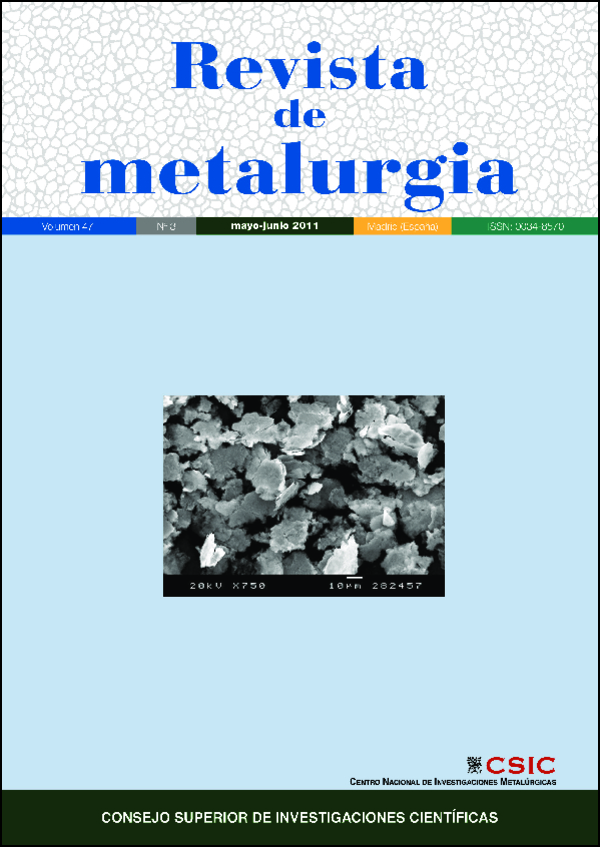Corrosion behaviour and in vitro/in vivo biocompatibility of surface-modified AZ31 alloy
DOI:
https://doi.org/10.3989/revmetalm.1065Keywords:
AZ31, Magnesium fluoride, Corrosion, Biocompatibility, In vitro/in vivoAbstract
The present work evaluates the corrosion behaviour and the in vitro/in vivo biocompatibility of the AZ31 magnesium alloy, which fulfills the mechanical requirements of bone. The corrosion kinetic of as-received AZ31 alloy was not compatible with the cell growth. To improve its performance, the AZ31 alloy was surface modified by a chemical conversion treatment in hydrofluoric acid. The magnesium fluoride layer generated by the surface treatment of AZ31 alloy enhances its corrosion behaviour, allowing the in vitro growth of osteoblastic cells over the surface and the in vivo formation of a highly compact layer of new bone tissue. These results lead to consider the magnesium fluoride coating as necessary for potential use of the AZ31 alloy as biodegradable and absorbable implant for bone repair.
Downloads
References
[1] T. Hanawa, Mater. Sci. Eng. C. 24 (2004) 745-752. http://dx.doi.org/10.1016/j.msec.2004.08.018
[2] M.P. Staiger, A.M. Pietak, J. Huadmai y G. Dias, Biomaterials 27 (9) (2006) 1.728-1.734.
[3] S.F. Yang, K.F. Leong, Z.H. Du y C.K. Chua, Tissue Eng. 7(6) (2001) 679-89. http://dx.doi.org/10.1089/107632701753337645 PMid:11749726
[4] Y. Al-Abdullat, S. Tsutsumi, N. Nakajima, M. Ohta, H. Kuwahara y K. Ikeuchi, Mater. Trans. 42 (2001) 1.777-1.780.
[5] R. Zeng, W. Dietzel, F. Witte, N. Hort y C. Blawert, Adv. Eng. Mater. 10 (2008) B03−B14.
[6] G.L. Song, Corros. Sci. 49 (2007) 1.696-1.701.
[7] F. Witte, N. Hort, C. Vogt, S. Cohen, K.U.Kainer, R. Willumeit y F. Feyerabend, Curr. Opin. Solid State Mater. Sci. 12(5-6) (2008) 63-72. http://dx.doi.org/10.1016/j.cossms.2009.04.001
[8] M. Álvarez-López, M.D. Pereda, J.A. del Valle, M. Fernández-Lorenzo, M.C. García-Alonso, O.A. Ruano y ML Escudero, Acta Biomater. 6 (2010) 1.763-1.771.
[9] X. Gu, Y. Zheng, Y. Cheng, S. Zhong y T. Xi, Biomaterials 30 (2009) 484-498. http://dx.doi.org/10.1016/j.biomaterials.2008.10.021 PMid:19000636
[10] F. Witte, V. Kaese, H. Haferkamp, E. Switzer, A. Meyer-Lindenberg y C.J. Wirth, Biomaterials 26 (2005) 3.557-3.563.
[11] K. Chiu, M. Wong, F. Cheng y H. Man, Surf. Coat. Technol. 202 (2007) 590-598. http://dx.doi.org/10.1016/j.surfcoat.2007.06.035
[12] M. Carboneras, L.S. Hernández, J.A. del Valle, M.C. García-Alonso y M.L. Escudero, J. Alloys Comp. 496(1-2) (2010) 442-448.
[13] J. Gray y B. Luan, J. Alloys Comp. 336 (2002) 88-113.
[14] A. Doyle, J.B. Griffiths y D.G. Newell, Testing for Microbial contamination, in: A. Doyle, J.B. Griffiths, D.G. Newell, (Eds.), Cell & Tissue Culture: Laboratory Procedures, John Wiley & Sons Ltd, Vol I, West Sussex, England, 1995, pp. 7A:1.2.
[15] J.A. del Valle, F. Carreño y O.A. Ruano, Acta Mater. 54 (2006) 4.247-4.259.
[16] V. Caesel, P.-T. Tai, Fr.-W. Bach, H. Haferkamp, F. Witte y H. Windhagen, Proceedings of the Sixth International Conference on Magnesium Alloys and Their Applications, K.U. Kainer (Ed.), 2003, pp. 534-539.
[17] M. Carboneras, L.A. Hernández-Alvarado, Y.E. Mireles, L.S. Hernández, M.C. García- Alonso y M.L. Escudero, Rev. Metal. Madrid 46 (2010) 86-92.
[18] Z. Li, X. Gu, S. Lou e Y. Zheng, Biomaterials 29 (2008) 1.329-1.344.
Downloads
Published
How to Cite
Issue
Section
License
Copyright (c) 2011 Consejo Superior de Investigaciones Científicas (CSIC)

This work is licensed under a Creative Commons Attribution 4.0 International License.
© CSIC. Manuscripts published in both the printed and online versions of this Journal are the property of Consejo Superior de Investigaciones Científicas, and quoting this source is a requirement for any partial or full reproduction.
All contents of this electronic edition, except where otherwise noted, are distributed under a “Creative Commons Attribution 4.0 International” (CC BY 4.0) License. You may read the basic information and the legal text of the license. The indication of the CC BY 4.0 License must be expressly stated in this way when necessary.
Self-archiving in repositories, personal webpages or similar, of any version other than the published by the Editor, is not allowed.
















